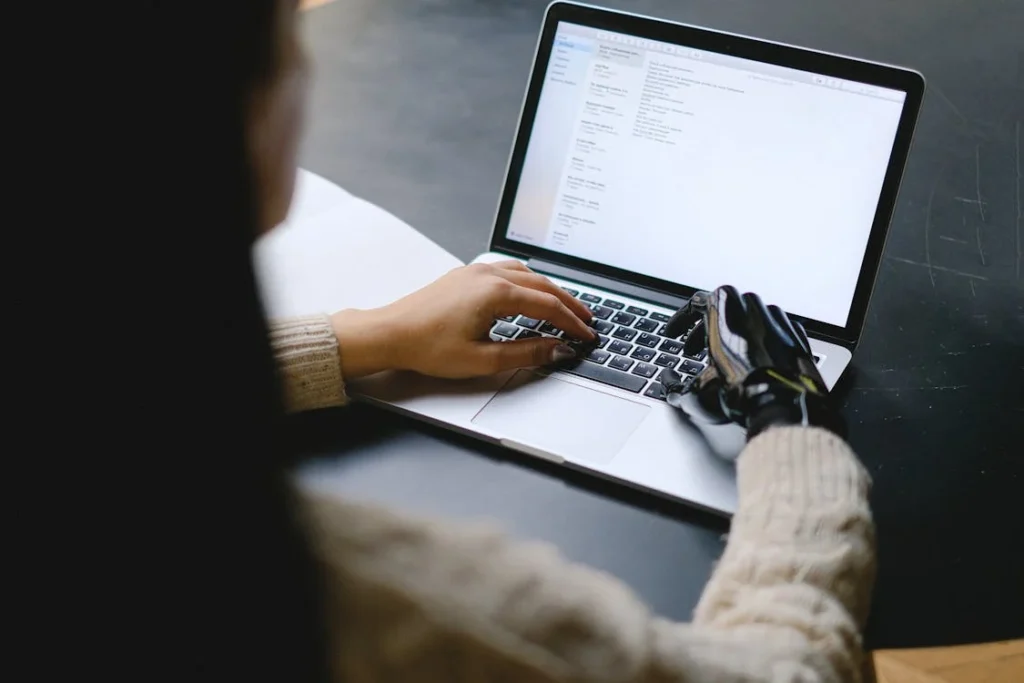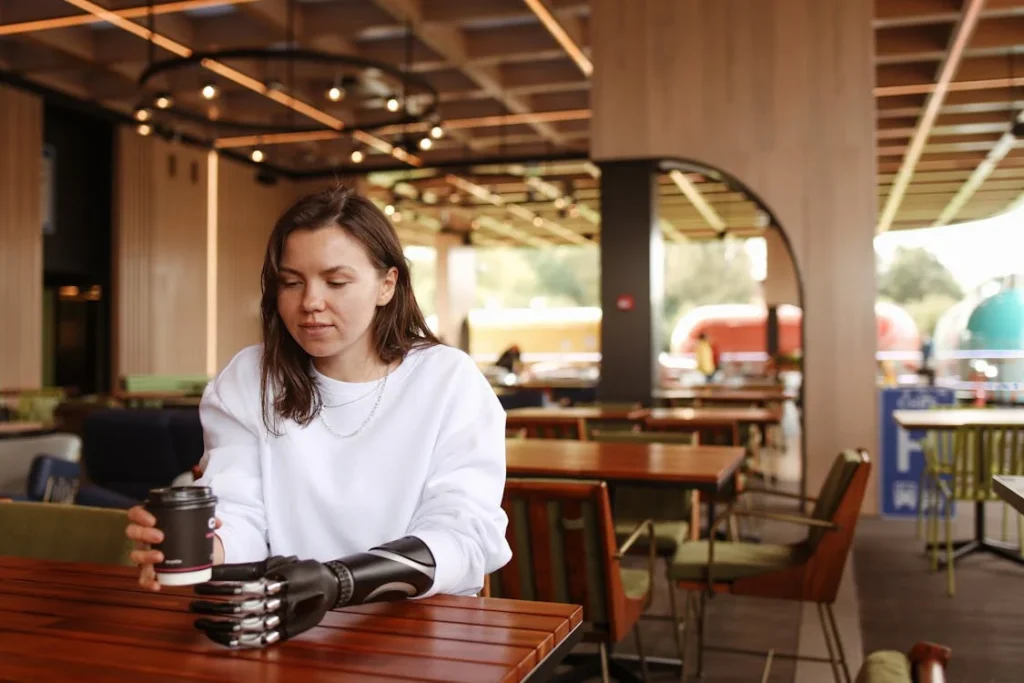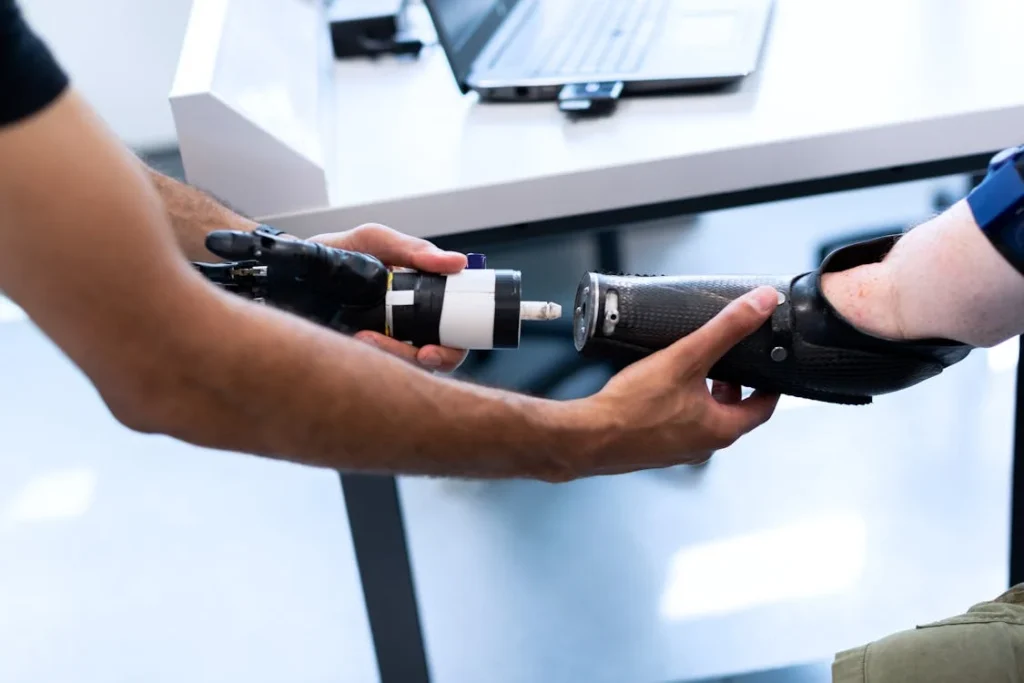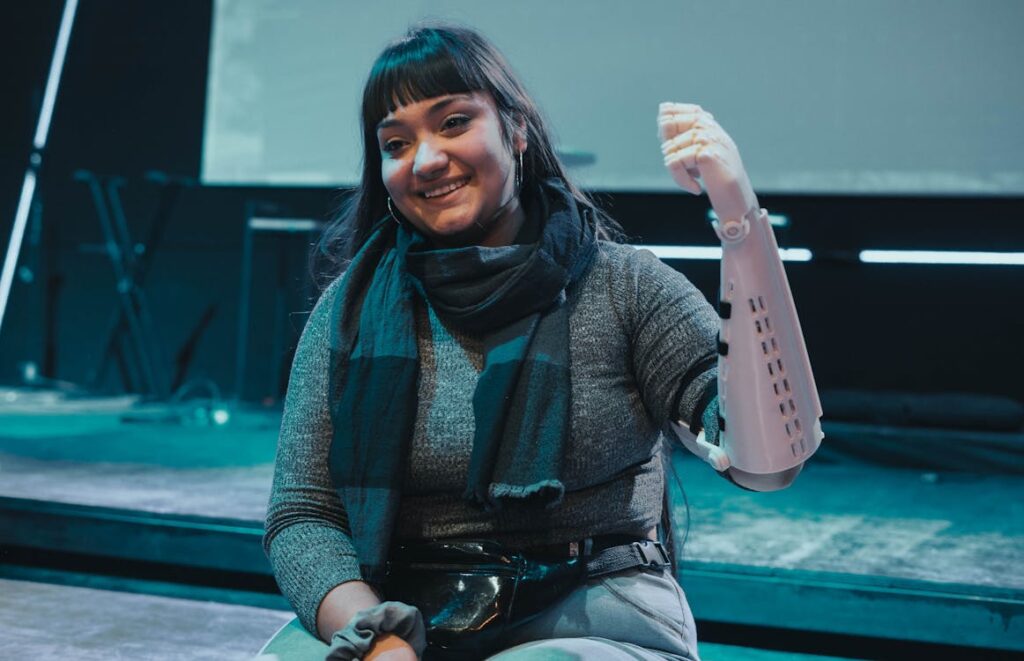For people with upper limb differences, daily activities and workplace tasks can present unique challenges. From holding a coffee cup to typing on a computer, many everyday actions rely on the use of both hands. However, modern upper limb prosthetics are changing the way people interact with the world, making tasks easier and restoring confidence.
Prosthetic technology has advanced rapidly in recent years. What was once a basic, mechanical solution has evolved into highly functional, responsive prosthetic hands that allow for precision, grip control, and even sensory feedback. These innovations are making a real impact, helping individuals regain independence in their personal lives and perform complex tasks in professional environments.

Enhancing Workplace Productivity with Prosthetic Hands
The modern workplace relies heavily on manual dexterity. Whether it’s a corporate office, a manufacturing plant, or a creative industry, employees use their hands for a variety of tasks.
For individuals with upper limb differences, prosthetic technology is opening new doors, allowing them to take on roles that were once considered difficult or impossible.
Using Prosthetics in Office Settings
In office environments, most tasks require fine motor skills, including typing, using a mouse, handling paperwork, or operating office equipment. For many prosthetic users, these activities can be challenging at first.
However, modern prosthetic hands are designed with advanced grip control, making it easier to handle delicate objects and perform repetitive tasks with precision.
Myoelectric prosthetics, which are controlled by electrical signals from the user’s muscles, allow for smooth and intuitive movements. With practice, users can type efficiently, navigate digital tools, and even use touchscreen devices with ease.
Adjustable grip strength is another game-changer. Many prosthetic hands now come with multiple grip modes, enabling users to switch between a firm hold for lifting objects and a light grip for delicate tasks.
This adaptability ensures that office workers can manage their workload without struggling with everyday tools.
Overcoming Workplace Barriers
Despite the advancements in prosthetic technology, some workplaces still need to make adjustments to accommodate prosthetic users fully.
Ergonomic workstations, voice-activated software, and assistive technologies can further enhance productivity and ease of use.
Employers are becoming more aware of the need for inclusivity, and many are now providing customized workplace solutions for employees with prosthetic limbs.
Flexible workspaces, accessible equipment, and awareness programs help create a supportive environment where everyone can thrive.
As more companies embrace diversity in the workplace, upper limb prosthetic users are finding new opportunities to excel in their careers.
With the right prosthetic hand and a supportive environment, individuals can take on roles in finance, administration, customer service, and even fields like IT and design.

Bridging the Gap in Hands-On Professions
While office jobs rely on fine motor skills and precision, many professions require physical labor, tool handling, or high levels of coordination.
For individuals with upper limb differences, working in industries like manufacturing, healthcare, construction, and culinary arts can present unique challenges.
However, modern prosthetics are closing the gap, allowing users to take on roles that demand strength, adaptability, and endurance.
Advancements in Prosthetic Grip and Dexterity
One of the key limitations of traditional prosthetic hands was their inability to grasp and manipulate objects with flexibility.
Many mechanical prosthetics offered only basic open-and-close functionality, making complex tasks difficult.
New-generation prosthetic hands now provide multiple grip patterns, allowing users to hold tools, grasp small objects, and adjust their grip strength depending on the task.
For example, in construction and manufacturing, workers need to handle everything from power tools to delicate components.
Prosthetic hands with adjustable grips and rotating wrists enable users to maintain stability while working with various materials.
Some models also integrate sensors that provide feedback, helping users judge how much pressure to apply when holding objects.
In fields like healthcare and caregiving, where precision and control are critical, prosthetic advancements are making it easier for professionals to perform tasks such as administering injections, dressing wounds, or handling medical equipment.
These improvements not only increase efficiency but also allow users to pursue careers that may have seemed out of reach in the past.
Customizing Prosthetics for Specialized Jobs
Not all workplaces require the same level of dexterity, which is why customization plays a crucial role in making prosthetics more effective.
Some prosthetic users require hands with precise finger movement, while others need a durable grip to handle heavier objects.
Modular prosthetics are now available, allowing users to switch between different attachments based on their needs.
For example, a chef may use a prosthetic attachment designed specifically for holding knives and kitchen utensils, while a mechanic might require a specialized grip for handling wrenches and other tools.
These personalized solutions make it possible for users to perform their jobs with confidence and efficiency.
Robobionics focuses on creating prosthetic hands that are both functional and adaptable, ensuring that users in various industries can find a solution that fits their needs.
Whether it’s a reinforced grip for manual labor or an adjustable wrist for delicate operations, modern prosthetics are breaking barriers in the professional world.
Overcoming Workplace Fatigue and Long-Term Wear
Wearing a prosthetic for extended periods can lead to muscle fatigue, especially for users in physically demanding jobs.
Weight distribution and ergonomic design play a major role in ensuring long-term comfort.
Prosthetics made from lightweight yet durable materials, such as carbon fiber or advanced polymers, help reduce strain while maintaining strength and durability.
Adjustable socket systems also improve wearability. As a user’s residual limb changes over time due to muscle adaptation or swelling, having a socket that can be adjusted ensures that the prosthetic remains comfortable and secure throughout the day.
Employers are also recognizing the need for prosthetic-friendly work environments. Many companies now provide ergonomic workstations, regular breaks, and assistive devices that help reduce strain.
These adaptations ensure that prosthetic users can perform their jobs effectively while maintaining their long-term health and comfort.
With the right prosthetic hand, proper training, and a supportive work environment, individuals with upper limb differences are proving that they can excel in hands-on professions.
As technology continues to evolve, more industries will become accessible to prosthetic users, creating new career opportunities and pathways to success.

Restoring Independence in Daily Activities
Beyond the workplace, upper limb prosthetics are transforming the way people approach everyday life.
Simple tasks such as dressing, cooking, driving, or even playing sports can become challenging after limb loss.
However, modern prosthetics are making these activities more accessible, restoring independence, and allowing users to engage in their daily routines with ease.
Regaining Control Over Household Tasks
Household activities such as cooking, cleaning, and personal grooming require both precision and grip strength. Traditional prosthetic hands often made these tasks difficult due to limited movement and lack of fine control.
Today, advanced prosthetics come with multiple grip patterns that allow users to handle delicate objects, turn knobs, and hold kitchen utensils more securely.
For example, holding a spoon or cutting vegetables requires a combination of stability and flexibility. Some prosthetics now offer wrist rotation and adjustable grip force, making it easier to control pressure and prevent objects from slipping.
Similarly, improved dexterity allows users to button shirts, tie shoelaces, and perform other self-care activities without assistance.
These innovations are particularly valuable for individuals who want to live independently without relying on caregivers for routine tasks. By regaining control over these activities, prosthetic users can build confidence and lead more self-sufficient lives.
Driving and Transportation
For many people, driving is an essential part of daily life, whether for commuting to work, running errands, or maintaining an active social life.
Operating a vehicle requires precise hand coordination, which can be a challenge for those with upper limb differences. However, new prosthetic designs and adaptive driving modifications are making it easier for prosthetic users to get back on the road.
Myoelectric prosthetics, which respond to muscle signals, provide better control for steering and operating dashboard controls.
Some prosthetic users also benefit from customized steering wheel attachments, which provide better grip and stability. Automatic transmission vehicles further simplify the driving experience, reducing the need for complex hand movements.
In addition to personal vehicles, many public transportation systems are becoming more accessible to prosthetic users.
Features such as touch-free payment systems, voice-activated ticketing, and ergonomic handrails ensure that individuals with upper limb prosthetics can navigate buses, trains, and taxis without difficulty.
Engaging in Sports and Recreation
Staying active is an important part of maintaining a healthy lifestyle, and upper limb prosthetics are now designed to support a wide range of recreational activities.
Whether it’s weightlifting, cycling, swimming, or playing musical instruments, specialized prosthetic attachments are enabling users to participate in hobbies and sports with greater ease.
Athletic prosthetics are designed to withstand high-impact activities while providing a secure grip.
Some models feature interchangeable attachments that allow users to switch between different sports, such as a specialized grip for tennis or a hook attachment for rowing.
For musicians, custom prosthetic designs enable users to play instruments such as the guitar, piano, or drums. These prosthetics are designed to mimic finger movement or provide stability for holding drumsticks or bow instruments.
The ability to engage in sports and hobbies not only improves physical health but also contributes to emotional well-being.
Many prosthetic users find that participating in recreational activities helps them build confidence, strengthen social connections, and regain a sense of normalcy in their lives.
The Psychological Impact of Regaining Daily Functionality
Beyond physical capability, prosthetic use has a profound psychological impact. The ability to perform daily tasks independently can significantly boost self-esteem and emotional well-being.
Many prosthetic users report feeling more in control of their lives, experiencing fewer limitations, and gaining a renewed sense of purpose.
Community support and rehabilitation programs also play a crucial role in this transition.
By engaging with peer support groups or working with occupational therapists, users can learn adaptive techniques and share experiences that make the adjustment process smoother.
With advancements in prosthetic technology, individuals are no longer limited in their personal and professional lives. Upper limb prosthetics are giving people the freedom to live life on their own terms, enabling them to participate fully in both work and play.

The Role of Prosthetic Training and Rehabilitation in Daily Life
Adapting to an upper limb prosthetic is not just about having the right device—it is also about learning how to use it effectively.
Many users face challenges when first incorporating their prosthetic hand into daily routines. From basic muscle training to advanced task-specific exercises, rehabilitation plays a critical role in making prosthetic use second nature.
The Importance of Initial Training
For new users, wearing a prosthetic hand can feel unfamiliar. The muscles in the residual limb may not be accustomed to sending signals to control a device, especially for myoelectric prosthetics.
Initial training focuses on strengthening these muscles and teaching users how to trigger different grip modes and movements.
Therapists use biofeedback techniques to help users understand how their muscle contractions influence prosthetic movements.
This involves visual or auditory cues that indicate when a signal is being sent correctly, allowing users to fine-tune their control. The more they practice, the more natural their movements become.
Simple exercises, such as squeezing a foam ball or performing slow, controlled wrist rotations, help build strength and precision. These early steps lay the foundation for more advanced tasks, making everyday activities easier in the long run.
Adapting to Personal and Professional Tasks
Once users have developed basic control, the next step is integrating their prosthetic into real-world activities. Occupational therapy focuses on helping individuals perform daily tasks efficiently, from holding utensils while eating to gripping pens for writing.
One of the key challenges in workplace settings is adjusting to repetitive tasks. For example, someone working in an office may need to practice typing, while a mechanic may need to refine their grip when using tools.
Task-specific training ensures that users develop the muscle coordination needed for their individual job requirements.
Gamified rehabilitation is also gaining popularity as a training method. Many users find it easier to practice movements through interactive games and virtual reality simulations.
These programs make training more engaging while allowing users to build muscle memory in a low-stress environment.
Overcoming Fatigue and Long-Term Adaptation
Using a prosthetic hand for long hours can lead to muscle fatigue, especially in the early stages. The body must adjust to the weight of the prosthetic, and even lightweight designs require some level of endurance.
Strength training and endurance-building exercises help users wear their prosthetic for longer periods without discomfort.
To prevent overuse injuries, therapists recommend balancing prosthetic use with natural limb movement whenever possible.
For tasks that require prolonged effort, taking short breaks or switching grip positions can reduce strain. Some advanced prosthetics are now incorporating AI-driven movement assistance, reducing the effort required for repetitive motions.
Long-term adaptation also involves maintaining a consistent training routine. Even experienced prosthetic users benefit from ongoing practice to refine their movements and adjust to new tasks.
Regular check-ins with a prosthetist ensure that the device remains comfortable and functional as the user’s needs evolve.
With proper training and rehabilitation, upper limb prosthetic users can gain full confidence in their device, allowing them to navigate both work and daily life with ease.
Continued advancements in technology and therapy methods will further enhance this process, making prosthetic adaptation smoother and more intuitive for future users.

The Future of Upper Limb Prosthetics in Work and Everyday Life
The rapid evolution of prosthetic technology is changing the way people with upper limb differences navigate their personal and professional lives.
As prosthetic hands become more advanced, lighter, and easier to control, they will continue to break down barriers and open new possibilities.
The future of prosthetics is not just about restoring function—it is about enhancing human capability and providing more independence.
Smarter and More Intuitive Prosthetics
Artificial intelligence and machine learning are revolutionizing how prosthetics function.
Traditional myoelectric prosthetic hands rely on muscle signals for control, but newer designs are integrating AI to learn from the user’s movements and improve responsiveness over time.
Instead of requiring deliberate muscle contractions to trigger different grips, AI-driven prosthetics anticipate the user’s intent based on past actions.
Some of the latest research involves brain-computer interfaces that allow direct neural control of prosthetic hands.
This means that in the future, users may be able to control their prosthetic fingers with the same level of precision as a biological hand, simply by thinking about the movement.
While this technology is still in its early stages, it holds great promise for making prosthetic hands feel like a seamless extension of the body.
Haptic feedback is another area of development. Some prosthetic hands are now equipped with pressure sensors that send signals back to the user, creating the sensation of touch.
This allows users to judge grip strength more accurately and interact with their environment in a more natural way.
As this technology advances, users will be able to distinguish textures, temperature, and even different levels of force through their prosthetic hand.
More Accessibility and Customization
While high-end prosthetic hands offer incredible functionality, cost remains a major challenge for many users. The future of prosthetic technology will focus on making advanced solutions more affordable and accessible.
3D printing has already played a huge role in reducing costs and improving customization, allowing for the production of lightweight, durable, and tailored prosthetics at a fraction of the price of traditional models.
Customization will continue to improve, with users having more options for both functionality and aesthetics.
Some prosthetic hands already allow for interchangeable components, where users can switch between different grip styles, wrist attachments, or even cosmetic designs depending on their needs.
This level of personalization ensures that prosthetics are not only functional but also fit seamlessly into each user’s lifestyle.
Additionally, localized production will make prosthetics easier to obtain. Instead of relying on international suppliers and long wait times, companies like Robobionics are focusing on regional manufacturing to deliver high-quality prosthetic hands faster and at a lower cost.
The Growing Role of Prosthetics in Society
As prosthetic technology improves, society’s perception of limb differences is also evolving. In the past, prosthetics were often seen as a medical necessity, but today, they are being embraced as tools for empowerment and self-expression.
Athletes with prosthetic limbs are competing at the highest levels, musicians are creating new ways to play instruments, and professionals across all industries are proving that limb differences are not a limitation.
Social awareness campaigns and inclusive workplace policies are ensuring that people with prosthetic limbs have the same opportunities as everyone else.
Education and training programs are also expanding, helping prosthetic users gain the skills they need to succeed in their careers.
More companies are investing in assistive technologies, workplace adaptations, and prosthetic-friendly job roles, creating a future where limb differences are no longer seen as a barrier to success.
With continuous advancements in technology, accessibility, and social integration, upper limb prosthetics will keep transforming lives—giving users more control, confidence, and opportunities in both their work and personal lives.

The Social and Economic Impact of Advanced Prosthetics
The growing use of upper limb prosthetics is not just benefiting individuals—it is having a significant impact on society and the economy as well.
As more people regain independence and enter the workforce, the potential for increased productivity and social inclusion continues to rise.
From reducing healthcare costs to improving workplace diversity, prosthetic advancements are driving positive change at multiple levels.
Reducing Healthcare Costs and Dependency
One of the biggest challenges for people with limb differences is the long-term cost of care.
Without proper assistive devices, individuals may require ongoing medical support, rehabilitation services, or personal assistance to complete daily activities. This dependency can place a financial burden on families and healthcare systems.
Modern prosthetics, especially those that incorporate AI and ergonomic designs, significantly reduce the need for external support.
By allowing users to perform everyday tasks without assistance, these devices help decrease the long-term expenses associated with caregiving and medical interventions.
Additionally, advanced prosthetics contribute to better mental and physical health, reducing the risk of secondary conditions such as musculoskeletal pain from overcompensation or depression caused by loss of independence.
More affordable prosthetic options, such as 3D-printed hands, are also improving access to mobility solutions.
By making high-quality prosthetics more cost-effective, individuals who previously could not afford them now have the opportunity to regain functionality without incurring massive expenses.
Increasing Employment Opportunities
The ability to work is one of the most crucial factors in achieving financial independence and self-sufficiency. Historically, people with upper limb differences faced significant barriers in employment due to limited accessibility, employer biases, and a lack of adaptive tools.
Today, however, upper limb prosthetics are making it easier for individuals to join and thrive in the workforce.
Companies are beginning to recognize the value of hiring individuals with prosthetic limbs, especially as technology allows them to perform tasks with the same level of efficiency as their peers.
Businesses that prioritize inclusivity benefit from a diverse workforce and improved innovation, as employees with different experiences often bring unique problem-solving skills.
Government policies and workplace accommodations are also making it easier for prosthetic users to pursue a wide range of careers. With the help of assistive devices, individuals are now working in fields such as engineering, medicine, finance, and even skilled trades.
This shift is helping to break down stereotypes and demonstrate that upper limb prosthetic users are just as capable as anyone else.
Encouraging Social Inclusion and Acceptance
In the past, people with visible prosthetic limbs sometimes faced social stigma or discomfort in public settings. However, attitudes are changing as prosthetic technology becomes more advanced, stylish, and widely accepted. Many users now see their prosthetics as a source of empowerment rather than a limitation.
Customization is playing a big role in this transformation. Prosthetic hands are no longer just functional devices—they are personal accessories that reflect the user’s identity.
Some individuals choose bionic-looking prosthetics that emphasize modern technology, while others prefer natural skin tones or even artistic designs that make a bold statement.
Public awareness campaigns and media representation are also helping normalize prosthetic use. High-profile athletes, musicians, and professionals with prosthetic limbs are showcasing their abilities on global platforms, inspiring others and changing societal perceptions.
As more prosthetic users share their experiences, the public is becoming more informed and accepting of limb differences.
The Future of Prosthetic Accessibility and Inclusion
Looking ahead, the focus will continue to be on making prosthetics even more accessible, affordable, and adaptable to different lifestyles. Advances in mass production, regional manufacturing, and digital customization will ensure that high-quality prosthetic hands reach more people than ever before.
Educational institutions and training centers will also play a vital role in preparing individuals for successful integration into the workforce. By equipping prosthetic users with specialized skills and workplace adaptation techniques, organizations can ensure that they have the same career opportunities as everyone else.
With continued investment in research, technology, and social inclusion, upper limb prosthetics will continue to break down barriers, transforming lives and strengthening communities. As innovation progresses, people with prosthetic hands will not only regain independence but also redefine what is possible in both work and everyday life.
Conclusion
Upper limb prosthetics are more than just assistive devices—they are tools of empowerment, allowing users to regain independence, pursue careers, and engage in daily life without limitations. With advancements in AI, ergonomic design, and adaptive technology, prosthetic hands are becoming more intuitive, functional, and accessible than ever before.
Beyond technology, shifting attitudes in workplaces and society are creating more opportunities for prosthetic users. Employers are embracing inclusivity, industries are adapting work environments, and public awareness is fostering greater acceptance. These changes are enabling individuals with limb differences to thrive in both personal and professional settings.
At Robobionics, we are committed to developing prosthetic solutions that enhance mobility, confidence, and quality of life. If you or a loved one is looking for a prosthetic hand that combines cutting-edge technology with affordability and comfort, book a free demo of Grippy™ today. Experience the future of bionic hands and take the next step toward limitless possibilities.


